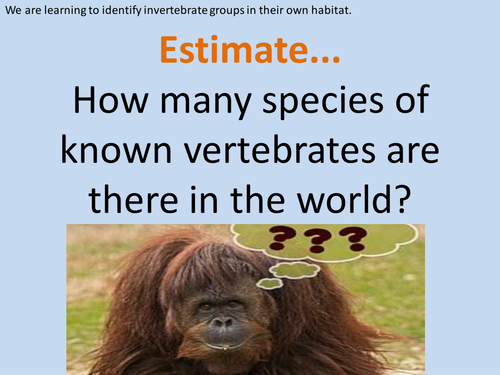








Lesson PowerPoint, planning and activities for identifying invertebrate groups and developing children's understanding of invertebrates that live in their local environment. Lots of mastery thinking required.
The fifth in a series of lessons to develop children's knowledge about 'Living Things and Their Habitats,' for the 2014 primary curriculum. Links to coverage of the curriculum are explicit in the planning.
We are learning to identify invertebrate groups in their own habitat.
An interesting starter to intrigue children and develop their scientific skills in estimating and discussing.
Recaps, revisits and builds on prior learning on living things, vertebrates and invertebrates.
Develop's children's scientific knowledge about grouping animals in different ways and looks at the specific scientific characteristics of invertebrate groups that are likely to be found in the local environment, as well as exploring examples of each group and their habitats.
Opportunity for outdoor work to identify invertebrate groups in the school grounds/ locality, with a focus on the type of habitat they were found in (recording sheet provided, although you will need bug hunting equipment from school and to set safety rules).
Lots of 'mastery' thinking required through the questions posed, for deepening and mastering learning.
Choice of 3 differentiated, engaging follow up activities to design a bug hotel, focusing on the type of habitat each invertebrate group would prefer (2 tasks are provided, all 3 are explained on the PowerPoint). Further resources e.g. prompt cards and pictures are provided too.
Opportunity for giving written peer feedback about the learning that has taken place.
An optional homework task is provided for children to develop their learning about classifying plants and consolidate their use of classification keys and scientific explanations.
All images have been taken from: http://search.creativecommons.org/ where no attribution is required.
The fifth in a series of lessons to develop children's knowledge about 'Living Things and Their Habitats,' for the 2014 primary curriculum. Links to coverage of the curriculum are explicit in the planning.
We are learning to identify invertebrate groups in their own habitat.
An interesting starter to intrigue children and develop their scientific skills in estimating and discussing.
Recaps, revisits and builds on prior learning on living things, vertebrates and invertebrates.
Develop's children's scientific knowledge about grouping animals in different ways and looks at the specific scientific characteristics of invertebrate groups that are likely to be found in the local environment, as well as exploring examples of each group and their habitats.
Opportunity for outdoor work to identify invertebrate groups in the school grounds/ locality, with a focus on the type of habitat they were found in (recording sheet provided, although you will need bug hunting equipment from school and to set safety rules).
Lots of 'mastery' thinking required through the questions posed, for deepening and mastering learning.
Choice of 3 differentiated, engaging follow up activities to design a bug hotel, focusing on the type of habitat each invertebrate group would prefer (2 tasks are provided, all 3 are explained on the PowerPoint). Further resources e.g. prompt cards and pictures are provided too.
Opportunity for giving written peer feedback about the learning that has taken place.
An optional homework task is provided for children to develop their learning about classifying plants and consolidate their use of classification keys and scientific explanations.
All images have been taken from: http://search.creativecommons.org/ where no attribution is required.
Something went wrong, please try again later.
This resource hasn't been reviewed yet
To ensure quality for our reviews, only customers who have purchased this resource can review it
Report this resourceto let us know if it violates our terms and conditions.
Our customer service team will review your report and will be in touch.
£2.35
